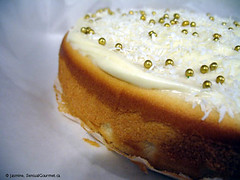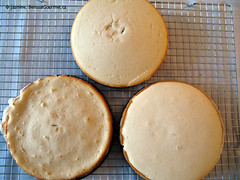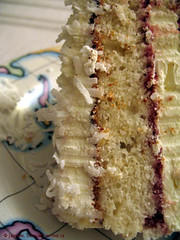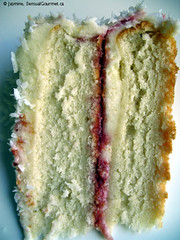 If you perused the Daring Baker Blogs in March, you know we were challenged to make Dorie's Perfect Party Cake. And if you perused enough of our blogs you'd have noticed a fair number of us had troubles getting our cakes to rise anything more than a galette. Dorie did hear of our troubles and passed on a note, suggesting we not try self-raising flour, use AP flour (less two tablespoons) and that her cake flour of choice was Swans Down.
If you perused the Daring Baker Blogs in March, you know we were challenged to make Dorie's Perfect Party Cake. And if you perused enough of our blogs you'd have noticed a fair number of us had troubles getting our cakes to rise anything more than a galette. Dorie did hear of our troubles and passed on a note, suggesting we not try self-raising flour, use AP flour (less two tablespoons) and that her cake flour of choice was Swans Down.Some people were able to use her advice and came up with some happy little slabs. I didn't see the note until it was too late, so I wound up with very dense, thin cakes, not really high enough to bisect to make a quadruple layer cake. Partly because I wasn't thrilled with the result, partly because I was surprised to find a recipe in Dorie's Baking tome that didn't work, and partly because I was worried that the key to this recipe was a very specific brand, I wanted to try this cake again.
Last week I made three half-recipes--one using my usual Five Roses AP Flour, one using my usual Robin Hood Cake and Pastry Flour and the last using Swans Down. All were made the same day, with each cake baking away on its own in my mum's oven. The only changes I made from the first go-round were switching to vanilla from lemon and using milk instead of buttermilk. I also timed all the beatings so they were all made in the same way. I'd not tried anything like this before, so I was curious as to how the cakes would differ.
 Here they are with heights
Here they are with heightsTop: Cake and Pastry Flour - 1.25" high
Left: AP - 1" high
Right: Swans Down - 1" high
Um...the dimples on the surface of the C&P Flour cake are not the result of a cat stepping on it--those are MY finger prints (yes, my initial doneness test is to touch the top of the cake).
Wow...look at that AP cake. All pockmarked and lumpy. In fact, by the time it totally cooled, it sank...I wound up with a bit of a crater.
Even though the C&P flour cake was the tallest, if I decided to slice off the dome, it would have been about 1" tall, the same height as the AP cake; the Swans Down domed slightly, but not enough to lose much height.
Well, there you go...none of my cakes were tall enough to slice through the middle as they were supposed to.
But this dawdle is about more than height..it's also about taste and texture....
 I didn't actually get to try the C&P slab as I gave it to Dear Friend, iced with some cream cheese icing, coconut and gold dragees. Here's a picture of the original cake It tasted quite nice and the crumb was a bit denser than many other cakes, but wasn't really heavy.
I didn't actually get to try the C&P slab as I gave it to Dear Friend, iced with some cream cheese icing, coconut and gold dragees. Here's a picture of the original cake It tasted quite nice and the crumb was a bit denser than many other cakes, but wasn't really heavy. The other two flours told a different story. The layer on the left is the Swans Down and the one on the right is the AP. Hands down, the Swans Down had the best texture of all three--almost velvety in its yielding crumb.
The other two flours told a different story. The layer on the left is the Swans Down and the one on the right is the AP. Hands down, the Swans Down had the best texture of all three--almost velvety in its yielding crumb. The AP Flour was much heavier and even though my cake tester came out clean it was obvious it should have been in the oven a wee bit longer, which contributed to its heavier nature.
At the end of this experiment I'm still not sure what's wrong--maybe I'm not making the cake correctly and that's why the slabs didn't rise all that much. I will say that I'm glad I tried the Swans Down Flour. My "everyday" cakes will still be made with my usual flours, but when I have a special cake on the menu, I know which flour I'll reach for...
cheers!
jasmine
Related Post: Daring Bakers: Perfect Party Cake

Wow! What an experiment! Thanks for letting us in on the results!
ReplyDeleteNow that is true and absolute Daring Baker Spirit! I am so impressed. I've used Swans Down very little but when a recipe says cake flour, it's the one I know. Now thanks to your dedication I know it's really the right one!
ReplyDeleteJasmine this is really interesting. I didn't take part in that challenge but I did read a lot of posts about thin layers. I find it surprising that even your highest rising cake was still not high enough to cut into the required layers. Very informative experiment!
ReplyDeleteTHis was interesting, I love tests like this! Thanks.
ReplyDeleteAs far as I know, in the US, Swan's Down only markets cake flour (has a lower protein % than all purpose flour). I've used both it and the Pillsbury equivalent, Softasilk, when making cakes. For a nice, basic cake recipe I rarely notice a difference between these specialty flours and generic AP flour. However, in "sponge" cakes where the white are whipped separately and folded in, I'll notice a texture difference like you saw, with the cake flour being silkier.
ReplyDeletehttp://www.swansdown.com/Portals/SwansDown/Portal.aspx?tabid=15
Neat experiment! Thanks for taking the time to blog about it.
Sheer dedication Jasmine! I for one am glad you went through all this and showed the results. (I still think it's a bit silly for a recipe to succeed only with a specific brand flour).
ReplyDeleteI'm giving this cake another round for a baby shower.Im sticking to the Swans. Glad your finally turned out !
ReplyDeleteI think it is great that you tried this experiment - it is the cause of a true baker to get an understanding of the recipe vs. its ingredients! Nice job!
ReplyDeleteI was sorry I missed this challenge, but I learned a lot about it from reading this post.
Welcome to The Foodie Blogroll!
I don't get it myself. I've made the cake recipe itself several times now, each time with the Robin Hood C&P flour, and had no problems. Last time I made it into cupcakes and again, had good rise and a nice cake.
ReplyDeleteI bet it was great with cream cheese frositng.
ReplyDeleteEven for those of us who don't bake, these types of experiments are so interesting to read about. I learn a lot -- and I'm happy to say that the Swan's is already in my pantry, should the baking genie descend upon my kitchen.
ReplyDeleteGreat experiment! I love that you didn't give up!
ReplyDeleteI think leaving the buttermilk out of this test may have been a mistake since I think it can affect leavening. Good flour study none-the-less!
ReplyDeleteHello all
ReplyDeleteYes, it was quite the doo--wasn't sure if any of them would rise, but I wasn't expecting the weird appearance from AP flour.
Dana - I had thought of that when I was doing it, but the end results prove otherwise as the C&P flour rose roughly the same amount with the milk as it did with the buttermilk...in fact I think it may have been a titch higher with the regular milk.
j
Hey, I happened by this blog and it's great - I have all sorts of problems making cakes. They come out tasty but . . . I don't know. Visually, not always good.
ReplyDeleteAll I can add from what I've read here is, maybe it's an issue of the actual weight of the flour? In other words, professional bakers (and I'm not one, just read about this) actually weigh the flour, they don't usually measure it in a measuring cup. I believe it has something to do with humidity in the air which can affect things. It seems nit-picky, but, as all of us decent cooks know, it's sometimes that one little thing that makes the difference between good and great in a recipe.
Great blog, nice to meet you and all! I'll be visiting often. : )
Julie